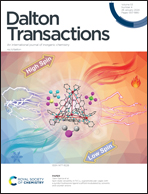Heterogeneous H2O2-based selective oxidations over zirconium tungstate α-ZrW2O8†
Abstract
Catalytic properties of a crystalline zirconium tungstate, ZrW2O8, the material known mainly for its isotropic negative coefficient of thermal expansion, have been assessed for the liquid-phase selective oxidation of a range of organic substrates comprising C![[double bond, length as m-dash]](https://www.rsc.org/images/entities/char_e001.gif) C, OH, S and other functional groups using aqueous hydrogen peroxide as the green oxidant. Samples of ZrW2O8 were prepared by hydrothermal synthesis and characterised by N2 adsorption, PXRD, SEM, EDX, FTIR and Raman spectroscopic techniques. Studies by IR spectroscopy of adsorbed probe molecules (CO and CDCl3) revealed the presence of Brønsted acidic and basic sites on the surface of ZrW2O8. It was demonstrated that ZrW2O8 is able to activate H2O2 under mild conditions and accomplish the epoxidation of C
C, OH, S and other functional groups using aqueous hydrogen peroxide as the green oxidant. Samples of ZrW2O8 were prepared by hydrothermal synthesis and characterised by N2 adsorption, PXRD, SEM, EDX, FTIR and Raman spectroscopic techniques. Studies by IR spectroscopy of adsorbed probe molecules (CO and CDCl3) revealed the presence of Brønsted acidic and basic sites on the surface of ZrW2O8. It was demonstrated that ZrW2O8 is able to activate H2O2 under mild conditions and accomplish the epoxidation of C![[double bond, length as m-dash]](https://www.rsc.org/images/entities/char_e001.gif) C bonds in alkenes and unsaturated ketones, oxidation of thioethers to sulfoxides and sulfones, along with the oxidation of alcoholic functions to produce ketones and aldehydes. The oxidation of tetramethylethylene and α-terpinene over ZrW2O8 revealed the formation of peroxidation products, 2,3-dimethyl-3-butene-2-hydroperoxide and endoperoxide ascaridole, respectively, indicating the involvement of singlet oxygen in the oxidation process. The ZrW2O8 catalyst preserves its structure and morphology under the turnover conditions and does not suffer from metal leaching. It can be easily recovered, regenerated by calcination, and reused without the loss of activity and selectivity.
C bonds in alkenes and unsaturated ketones, oxidation of thioethers to sulfoxides and sulfones, along with the oxidation of alcoholic functions to produce ketones and aldehydes. The oxidation of tetramethylethylene and α-terpinene over ZrW2O8 revealed the formation of peroxidation products, 2,3-dimethyl-3-butene-2-hydroperoxide and endoperoxide ascaridole, respectively, indicating the involvement of singlet oxygen in the oxidation process. The ZrW2O8 catalyst preserves its structure and morphology under the turnover conditions and does not suffer from metal leaching. It can be easily recovered, regenerated by calcination, and reused without the loss of activity and selectivity.



 Please wait while we load your content...
Please wait while we load your content...